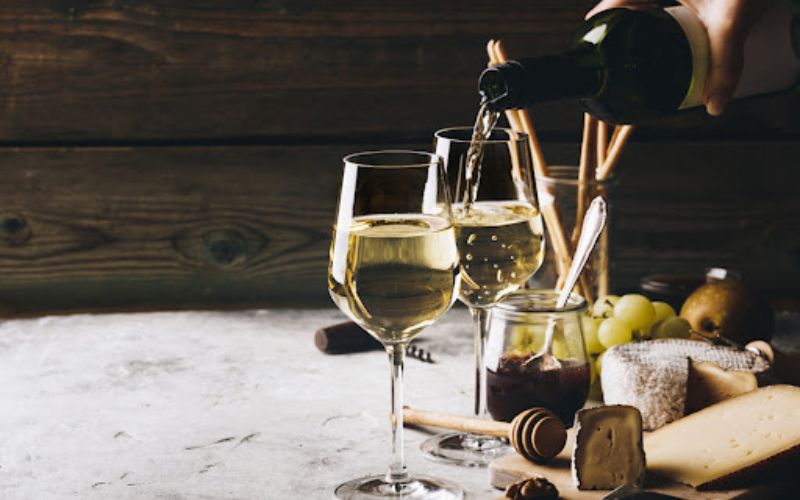
Chardonnay vs. Sauvignon Blanc: The Battle of the Whites


Wine enthusiasts are always on the lookout for the perfect white wine, either to pair with their meals or simply to enjoy all on its own. When it comes to popular white wines, there are two main contenders that first come to mind: Sauvignon Blanc and Chardonnay. Indeed, these two varieties are often regarded as the world’s top two white wine choices, with several reasons as to why they have achieved such widespread popularity, including versatility, availability and individual appealing flavours.
A well practised oenophile will generally have a preference of one over the other, but what about the everyday person who can’t tell white wine from white vinegar? The truth is that to the untrained palette, it can be somewhat difficult to tell these two popular wines apart.
Whether you’re new to vino, or simply someone who is looking to expand your existing wine knowledge, there is always something new to learn when it comes to the world of fine wine. Today, we explore the difference between Chardonnay and Sauvignon Blanc in the battle of the white wines, in a bid to help you choose the wine that best suits your personal taste preferences. Read on to find out more.

When comparing these two beloved white wines, it is important to start off with history and origin. Sauvignon Blanc is a white grape variety that originated in the Bordeaux region of France, and is now successfully grown in emerging and established wine regions all over the world such as Australia, New Zealand, Chile, and the United States. It is believed to have been first cultivated in the 18th century, although its exact origins are unclear.
On the other hand, Chardonnay is a green-skinned grape variety that originated in the Burgundy region of France. It is believed to have been first cultivated in the village of Chardonnay in the 12th century, hence its name. From Burgundy, the production of Chardonnay spread to other regions in France and eventually to other parts of the world, including wine regions in the United States, Australia, and New Zealand.

Although both Chardonnay and Sauvignon Blanc are considered two of the most popular of white wines in the world, they each feature their very own unique characteristics, mouth feel and flavour profiles. These distinct flavour profiles are influenced by various factors, such as the climate, soil, and winemaking techniques used in their production.
Chardonnay: One of the primary flavour components of Chardonnay is its fruity profile. This grape is known for its ripe tropical fruit flavours, including notes of mango, pineapple and papaya. These flavours are particularly prominent in Chardonnays grown in warmer climates, such as California and parts of Australia. In cooler climates, Chardonnay may exhibit more citrus flavours, such as lemon, lime, and grapefruit. Additionally, Chardonnay is widely known for its rich, creamy, and buttery flavours that can be further amplified by malolactic fermentation, more of which we will touch on later in this article. It is a full-bodied wine with a smooth texture and a hint of oak, pairing perfectly with foods like chicken, seafood, and pasta.
Sauvignon Blanc: In contrast, Sauvignon Blanc is known for its crisp, refreshing, and fruity flavours. It is a light-bodied wine with high acidity, and it has flavours of green apple, pear, lemon, and grapefruit. Another important factor in the flavour profile of Sauvignon Blanc is its herbal and vegetal notes. These flavours can include green capsicum, grass, jalapeno, and tomato leaf. In some varieties, these flavours can be quite pronounced, creating a distinct and unique flavour profile. These herbaceous notes are particularly common in Sauvignon Blancs grown in cooler regions with high acidity, as the cooler temperatures can help to preserve these flavours that pair well with foods like salads, goats cheese, seafood, and poultry.

The winemaking techniques used in the production of Chardonnay and Sauvignon Blanc play a huge role in their final distinct flavours. Chardonnay is often aged in oak barrels, which gives it a much loved creamy and buttery flavour. Some winemakers also choose to put Chardonnay through malolactic fermentation, which further contributes to buttery or creamy notes to the wine.
Malolactic fermentation is a process in which the wine undergoes a secondary fermentation, converting malic acid to lactic acid. This can soften the wine's acidity and add a creamy texture to the wine. However, not all Chardonnays undergo malolactic fermentation, and some winemakers prefer to preserve the grape's natural acidity and avoid the creamy texture.
Sauvignon Blanc, on the other hand, is usually aged in stainless steel tanks or neutral oak barrels, which helps to preserve its crisp and fruity flavours. However, with that said, some winemakers have successfully experimented with oak barrel ageing for a more complex flavour profile. This variety of wine is also typically fermented at a lower temperature to preserve its fresh and fruity characteristics. It is important to note that unlike Chardonnay, Sauvignon Blanc is typically not subjected to malolactic fermentation, as this can alter its fresh and zesty flavour profile.
Unsurprisingly, alcohol content is an important factor, as it can greatly impact the overall taste and experience of any wine. Unbeknownst to many, there are some key differences in alcohol content when comparing Chardonnay to Sauvignon Blanc. For starters, Chardonnay grapes generally contain low amounts of sugar, resulting in high alcohol levels (13% to 14.5%).
In contrast, Sauvignon Blanc tends to have lower alcohol content due to higher amounts of sugar content in grapes (11.5% to 13.5%).
The differences in alcohol content between Chardonnay and Sauvignon Blanc can also impact the taste and mouthfeel of the wine. Wines with higher alcohol content tend to be fuller-bodied and have a more pronounced taste, while wines with lower alcohol content tend to be lighter and more delicate in flavour.
Alcohol content also plays a major role when pairing wine with food. Lighter-bodied wines with lower alcohol content, like Sauvignon Blanc, tend to pair well with lighter dishes such as seafood, salads, and vegetables. On the flipside, fuller-bodied wines with higher alcohol content, like Chardonnay, pair well with heartier dishes like poultry and cream-based sauces. More on food pairings below.

Food and wine pairings have been practised for centuries, and with good reason too. Not only can wine enhance the flavour of your meals when paired correctly, but it can also help to cleanse the palate between bites of food, allowing diners to fully appreciate the flavours of each course. When it comes to food pairings, Chardonnay and Sauvignon Blanc offer some key differences that allow them to pair with different dishes for ultimate dining perfection.
Chardonnay: Chardonnay is a full-bodied wine that pairs well with rich, butter and creamy dishes. Since it is well known for its buttery and oaky flavours, it makes for an excellent match with dishes featuring a similar profile. It is a versatile wine that can be paired with a variety of foods including lobster, grilled chicken, cream sauces, butter sauces, creamy pasta dishes and roasted pork tenderloin.
Sauvignon Blanc: On the other hand, Sauvignon Blanc is a lighter-bodied wine with higher acidity levels. This ensures that it pairs well with lighter dishes such as appetisers and seafood. Sauvignon Blanc has a refreshing and crisp flavour that goes well with salads, bruschetta, light pasta dishes, and grilled vegetables. It also pairs well with spicy dishes because the acidity in the wine helps to balance the heat of the spices.
At the end of the day, the choice between Sauvignon Blanc and Chardonnay ultimately comes down to personal preference and the occasion. Both varieties are uniquely delicious white wines that are loved by hundreds of thousands of people due to their individual flavour profiles and characteristics. If you prefer a wine with a crisper and more refreshing mouthfeel, we recommend picking up a bottle of Sauv Blanc. For those who are after a more buttery flavour profile, you simply cannot go wrong with a quality bottle of Chardonnay. Ultimately, it's best to try both wines and see which one you prefer. Wine tasting events or visiting a local winery can be a fun and informative way to explore different varietals and find your perfect match.
_________________
What is your take on the battle of the white wines? Are you team Chardonnay or team Sauvignon Blanc? Be sure to let us know in the comments below!

